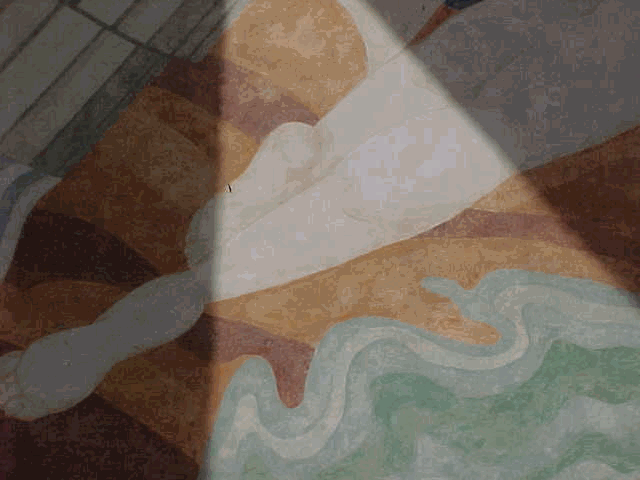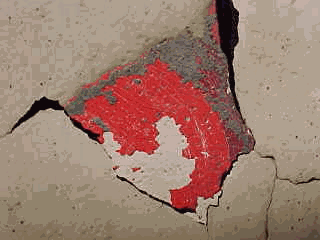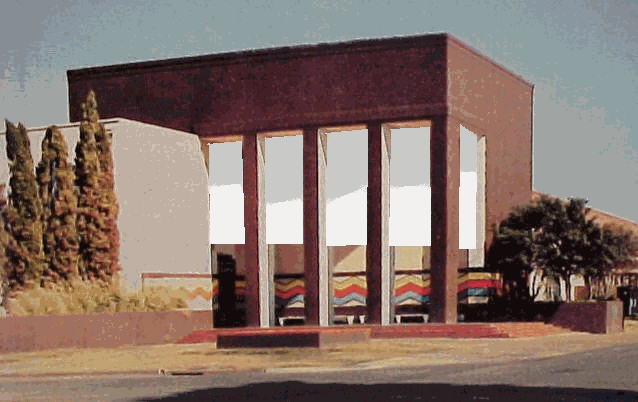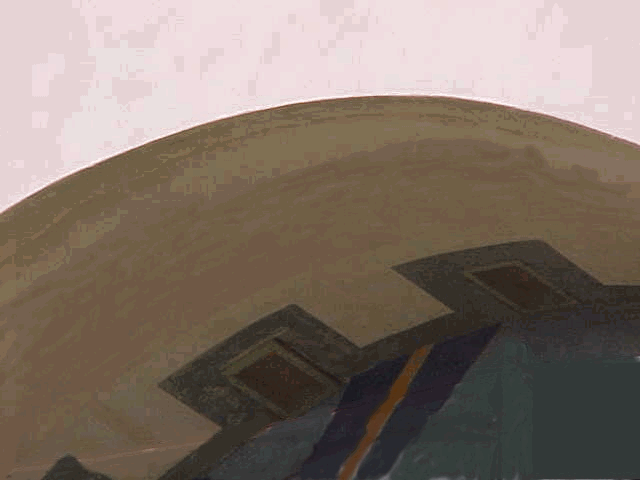Mural Fading Information and
Sun Abatement Proposal
The Problem
It has been clear to every conservation professional that has inspected these murals over the years that certain colors used for the painting of the murals are sensitive to light and will fade, some quickly, when exposed to sunlight. Since many sections of murals are exposed to direct sunlight, the situation is very alarming. Protecting the murals from direct sunlight and reducing the overall light levels as much as possible should be considered the highest priority as part of the mural’s preservation plan. Indeed, it would be irresponsible to uncover the murals only to let the sun fade them away.
Outdoor murals are always the art world’s most difficult child to take care of. The world has no outdoor murals older than this century that are in good condition. In some cases we admire only scant remnants and ghost images of original masterpieces from past centuries.

Traction – the uneven color in the background is the difference between an area of original paint that has been
exposed to light for some time (unknown how long) and an area that has been covered with overpaint until now.
Concerning the Fair Park murals, fading has been and presently is an issue. We have been able to compare areas of faded original paint next to unexposed original paint (where flaking has occurred). The differences are alarming. In some areas where the overpaint flaked off long ago and the original paint has been subjected to maybe decades of direct sunlight, the original colors have faded completed away. To help prove the point, take note that the mural, Future Transportation, may have faded significantly since the completion of it’s conservation treatments in 1996.

Future of Transportation – splotchy-ness and uneveness (very visible in green area) may be due to faded
original paint that used to match the inpainting. This photo shows the mural being hit by direct sunlight
In many cases, not only is the original color effected, but since the colors of some sections or details of the murals were obtained by layering several different pigments over one another, when the top color fades, it reveals the underlying color thereby changing the color and the composition.
The report by Perry Huston and Associates states,
“Fading from prolonged exposure to intense sunlight, damaging ultra-violet light and heat was present on all the murals where original paint was exposed. Where the vibrant colors of the original paint have been unprotected by overpaint, the colors are now powdery, dull and faded. This has produced the serious visual imbalance dramatically illustrated in “Traction”.

An example of previously flaked paint (bright red) which has
faded and changed next to newly exposed paint (darker red/purple)
The Proposal
The murals at Fair Park have a better chance of survival than most because:
They are protected under porches
They have been covered over for decades so that fading has somewhat been limited.
We have the awareness and materials to combat deteriorating influences.
Sophisticated monitoring devices and techniques are not required in order to know that these murals should not be exposed to the direct Dallas sunlight and that damage from exposure is severe. While monitoring may produce interesting data, it is highly recommended to act now to protect the paint layers.
No proposal will completely protect the murals without changing the architecture and enclosing the murals (ambient controls would also be required). Therefore, assuming that altering the historic design of the buildings is not an option then we must also accept that the murals will continue to be subjected to the flexuations of outdoor conditions. We can, however, eliminate the direct sunlight that falls on the murals. This in turn will reduce the heat exposure. By eliminating direct sunlight, general light levels will also be greatly reduced and this would contribute greatly to reducing fading. The influence of driving rain and wind will also be reduced significantly.
A simple shielding of the murals (on going and continuous) will contribute greatly to their long term preservation and best appearance. The following proposal can be a stop-gap intervention or could be a satisfactory long term resolution. This is a low cost, temporary (removable) option for the protection of the murals against direct sun. This option does not permanently impact or modify the design of the architecture.
The banner-like screens are attached to eye bolts installed at the sides of the openings in the building’s porches in the same way that banners are presently used at fairs and special events. The screen can be tinted or printed with designs (or images of the murals). The banner/screens can let air and some light pass through.

The Food and Fiber Building with screens installed to protect the murals from direct sunlight. The screens could be printed a specific color to help them blend better with the architecture or could be printed with images of the murals to simulate the historic presentation of the building from a distance.
Expected Results
An interesting practical example of what a minimal amount of protection can offer can be seen on the Women’s Building mural “alcove” decorative painting. This is in the arched architectural form around the mural (already treated).
In the lower areas of these walls, the direct sun has beat hard on the decorative painting for 64 years. The lower areas of the walls (lower half) have no image or color left. But the top section that has been protected from the direct sun (minimally) by the arch still has something to see.
In the apex of the arch, original colors and design are very discernable. As the wall begins to be vertical, the design element begins to fade away. The farther down on the wall, and the more sun that the decorative painting receives, the less original paint is visible.

One the South side of the Women’s Museum is located this “alcove” around the mural. At the apex of this arch the
green geometric designs, contoured by a yellow band then filled in with a peach color field is still very visible.
The painted decoration fades to nothing once it leaves the protection of the arch.
While the condition of the decorative painting at the apex of the alcove is in unacceptable condition for the murals, this example shows us that exposed painted surfaces do not survive even within a relatively short historic period and that minimally protected paint surfaces can benefit greatly. The murals on the Centennial Building and the Food and Fiber Building are protected partially by the porch overhang (much better protection than the arch of the alcove) and with the protective banner/screens, the direct sunlight would be eliminated. It is reasonable to assume that by blocking the direct light from reaching the murals we will greatly increase their chance to survive.
Action must be taken now. Immediate protection is needed for Future Transportation, Motion, Traction and Old Methods of Transportation. Before the end of May, we will need to protect two others on the Centennial Building. By the end of June, two more will be ready. In June two more murals will be ready and we will begin work on the Food and Fiber Building. By Fall, all the murals will require protection.
Scott M. Haskins, Senior Conservator
FACL, Inc.
